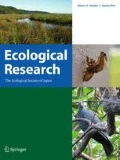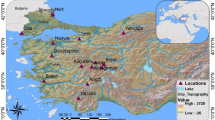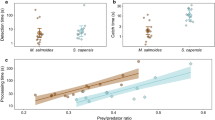Abstract
This review focuses on how predator performance of the invasive largemouth bass [Micropterus salmoides (Lacepède)] has been, or will be, formed in Japanese freshwaters. Predation impacts of largemouth bass on fish communities appear pervasive in both Japanese as well as North American freshwaters. Factors affecting performance as a piscivorous predator are (1) light intensity and water clarity, (2) oxygen depletion, (3) prey size and gape size, (4) behavioral refuge of prey, (5) weed beds as refuge for prey fish, (6) interaction with bluegill. Size and behavioral refuges requirements are so rigorous that they may have evolved only in some North American prey fish species like bluegill; therefore, most Japanese native fish species are unlikely to be equipped with such refuges. However, refuge habitats like aquatic weed beds could develop in Japanese freshwaters, allowing prey fish species to survive under predation pressure. The density, architecture, and species composition of aquatic plants may affect their suitability as refuges. Studies in Japanese waters have suggested that the presence of rich aquatic vegetation or invasive bluegill in bass-introduced waters have suppressed the predation impact of largemouth bass on fish communities. In addition to these environmental factors, original genotypic and phenotypic traits of the introduced largemouth bass, and hybridization between different lineages of largemouth bass or with Florida bass [Micropterus floridanus (Lesueur)] may be involved in further adaptation of invasive largemouth bass to Japanese freshwaters.
Similar content being viewed by others
References
Akaboshi T (1993) Black-bass (in Japanese). Ihatov-syuppan, Tokyo
Aoki D, Nakayama Y, Hayashi M, Iwasaki G (2006) Genetic diversity and origin of Florida largemouth bass (Micropterus salmoides floridanus) introduced into Lake Biwa inferred from the mitochondrial DNA control region (in Japanese). Jpn J Conserv Ecol 11:53–60
Applegate RL, Mullan JW (1966) Food of young largemouth bass, Micropterus salmoides, in a new and old reservoir. Trans Am Fish Soc 96:75–77
Azuma M (1992) Ecological release in feeding behaviour: the case of bluegills in Japan. Hydrobiologia 243/244:269–276
Azuma M (2002) Interspecific relationships between bluegill, largemouth bass, and native fish (in Japanese). In: Committee for Nature Conservation of the Ichthyological Society of Japan (ed) Black bass: its biology and ecosystem effects. Koseisha-koseikaku, Tokyo, pp 69–86
Azuma M, Motomura Y (1998) Feeding habits of largemouth bass in a non-native environment: the case of a small lake with bluegill in Japan. Environ Biol Fishes 52:379–389
Bettoli PW, Maceina MJ, Noble RL, Betsill RK (1992) Piscivory in largemouth bass as a function of aquatic vegetation abundance. North Am J Fish Manag 12:509–516
Brenden TO, Murphy BR (2002) Trophic dynamics of a slow growing age-0 largemouth bass cohort from a Virginia small impoundment. J Freshwater Ecol 17:609–619
Brown SJ, Maceina MJ (2002) The influence of disparate levels of submersed aquatic vegetation on largemouth bass population characteristics in a Georgia reservoir. J Aquat Plant Manag 40:28–35
Carpenter SR, Kitchell JF, Hodgson JR, Cochran PA, Elser JJ, Elser MM, Lodge DM, Kretchmer D, He X (1987) Regulation of lake primary productivity by food web structure. Ecology 68:1863–1876
Dibble ED, Harrel SL (1997) Largemouth bass diets in two aquatic plant communities. J Aquat Plant Manag 35:74–78
Drenner RW, Baca RM, Gilroy JS, Ernst MR, Jensen DJ, Marshall DH (2002) Community responses to piscivorous largemouth bass: a biomanipulation experiment. Lake Reserv Manage 18:44–51
Fields R, Lowe SS, Kaminski C, Whitt GS, Philipp DP (1987) Critical and chronic thermal maxima of northern and Florida largemouuth bass and their reciprocal F1 and F2 hybrids. Trans Am Fish Soc 116:856–863
Fuller P, Nico LG, Williams DD (1999) Nonindigenous fishes introduced into inland waters of the United States. Special publication 27. American Fisheries Society, Bethesda
Hamada A (2002) Lake Kasumigaura (in Japanese). In: The Ecological Society of Japan (ed) Handbook of alien species in Japan. Chijin-shokan, Tokyo, pp 265–268
Hambright KD (1991) Experimental analysis of prey selection by largemouth bass: role of predator mouth width and prey body depth. Trans Am Fish Soc 120:500–508
Hambright KD, Drenner RW, McComas SR, Hairston NG Jr (1991) Gape-limited piscivores, planktivore size refuges, and the trophic cascade hypothesis. Arch Hydrobiol 121:389–404
Hoyle JA, Keast A (1987) The effect of prey morphology and size on handling time in a piscivore, the largemouth bass (Micropterus salmoides). Can J Zool 65:1972–1977
Jackson DA (2002) Ecological effects of Micropterus introductions: the dark side of black bass. In: Philipp DP, Ridgway MS (eds) Black bass: ecology, conservation, and management. American Fisheries Society Symposium, 31. American Fisheries Society, Bethesda, pp 221–232
Jackson DA, Somers KM, Harvey HH (1992) Null models and fish communities: evidence of nonrandom patterns. Am Nat 139:930–951
Jackson DA, Peres-Neto PR, Olden JD (2001) What controls who is where in freshwater fish communities—the roles of biotic, abiotic, and spatial factors. Can J Fish Aquat Sci 58:157–170
Japanese Ministry of the Environment (1993) Fourth Survey Report of the National Survey on the Lake and Marsh. http://www.biodic.go.jp/english/kiso/fnd_f.html
Japanese Ministry of the Environment (2005) The Invasive Alien Species Act. http://www.env.go.jp/nature/intro/3shiryou.html
Johannes MRS (1993) Prey aggregation is correlated with increased predation pressure in lake fish communities. Can J Fish Aquat Sci 50:66–73
Karube H (2002) Effects of largemouth bass on aquatic insects (in Japanese). In: Committee for Nature Conservation of the Ichthyological Society of Japan (ed) Black bass: its biology and ecosystem effects. Koseisha-koseikaku, Tokyo, pp 61–68
Kiryuu T (1992a) Distribution range and habitat waters of largemouth bass in Japan (in Japanese). In: National Federation of Inlandwater Cooperatives (ed) The review of exotic largemouth bass Micropterus salmoides and bluegill Lepomis macrochirus. Fisheries Agency Japan, Tokyo, pp 20–27
Kiryuu T (1992b) Distribution range and habitat waters of bluegill in Japan (in Japanese). In: National Federation of Inlandwater Cooperatives (ed), The review of exotic largemouth bass Micropterus salmoides and bluegill Lepomis macrochirus. Fisheries Agency Japan, Tokyo, pp 89–91
Kitagawa T, Okita T, Banno Y, Sugiyama S, Okazaki T, Yoshioka M, Kashiwagi M (2000) Mitochondrial DNA of the Florida subspecies of largemouth bass Micropterus salmoides floridanus detected in Ikehara Reservoir, Nara Prefecture, Japan (in Japanese). Nippon Suisan Gakkaishi 66:805–811
Kitagawa E, Kitagawa T, Noso N, Yoshitani K, Hosoya K (2005) Increased frequency in the Ikehara Resevoir population and dispersion to other lakes and ponds of the genes originating from the Florida subspecies of the largemouth bass (in Japanese). Nippon Suisan Gakkaishi 71:146–150
Lorenzoni M, Dorr AJM, Erra R, Giovinazzo G, Mearelli M, Selvi S (2002) Growth and reproduction of largemouth bass (Micropterus salmoides Lacepede, 1802) in Lake Trasimeno (Umbria, Italy). Fish Res 56:89–95
Maceina MJ (1996) Largemouth bass abundance and aquatic vegetation in Florida lakes: an alternative interpretation. J Aquat Plant Manag 34:43–47
Maezono Y, Miyashita T (2003) Community-level impacts induced by introduced largemouth bass and bluegill in farm ponds in Japan. Biol Conserv 109:111–121
Maezono Y, Kobayashi R, Kusahara M, Miyashita T (2005) Direct and indirect effects of exotic bass and bluegill on exotic and native organisms in farm ponds. Ecol Appl 15:638–650
Magnuson JJ, Beckel AL, Mills K, Brandt SB (1985) Surviving winter hypoxia: behavioral adaptations of fishes in a northern Wisconsin winterkill lake. Environ Biol Fishes 14:241–250
Maruyama T (2002) Bass fishing and administrative actions to it (in Japanese). In: Committee for Nature Conservation of the Ichthyological Society of Japan (ed) Black bass: its biology and ecosystem effects. Koseisha-koseikaku, Tokyo, pp 99–125
McMahon TE, Holanov SH (1995) Foraging success of largemouth bass at different light intensities: implications for time and depth of feeding. J Fish Biol 46:759–767
Miller KD, Kramer RH (1971) Spawning and early life history of largemouth bass (Micropterus salmoides) in Lake Powell. In: Hall GE (ed) Reservoir fisheries and limnology. American Fisheries Society Special Publication 8. American Fisheries Society, Bethesda, pp 78–83
Miranda LE, Driscoll MP, Allen MS (2000) Transient physicochemical microhabitats facilitate fish survival in inhospitable aquatic plant stands. Freshwater Ecol 44:617–628
Mittelbach GG, Persson L (1998) The ontogeny of piscivory and its ecological consequences. Can J Fish Aquat Sci 55:1454–1465
Mittelbach GG, Turner AM, Hall DJ, Rettig JE, Osenberg CW (1995) Perturbation and resilience: a long-term, whole-lake study of predator extinction and reintroduction. Ecology 76:2347–2360
Nakai K, Hamahata E (2002) Lake Biwa (in Japanese). In: Ecological Society of Japan (ed) Handbook of alien species in Japan, Chijin-shokan, Tokyo, pp 257–259
Nishino M (2006) Comparison of fish fauna among satellite lakes of Lake Biwa (in Japanese). In: Nishino M, Hamahata E (eds) Messages from satellite lakes. Sunrise Shuppan, Hikone, pp 141–155
Olson MH (1996a) Ontogenetic niche shifts in largemouth bass: variability and consequences for first-year growth. Ecology 77:179–190
Olson MH (1996b) Predator-prey interactions in size-structured fish communities: implications of prey growth. Oecologia 108:757–763
Olson MH, Mittelbach GG, Osenberg CW (1995) Competition between predator and prey: resource-based mechanisms and implications for stage-structured dynamics. Ecology 76:1758–1771
Philipp DP, Claussen JE, Kassler TW, Epifanio JM (2002) Mixing stocks of largemouth bass reduces fitness through outbreeding depression. In: Philipp DP, Ridgway MS (eds) Black bass: ecology, conservation, and management, American Fisheries Society Symposium 31. AFH, Bethesda, pp 349–363
Polis GA, Myers CA, Holt RD (1989) The ecology and evolution of intraguild predation: potential competitors that eat each other. Annu Rev Ecol Syst 20:297–330
Savino JF, Stein RA (1989) Behavioural interactions between fish predators and their prey: effects of plant density. Anim Behav 37:311–321
Senou H (2002) Taxonomy of black bass introduced to Japan (in Japanese). In: Committee for Nature Conservation of the Ichthyological Society of Japan (ed) Black bass: its biology and ecosystem effects. Koseisha-koseikaku, Tokyo, pp 47–59
Takahashi K (2002) Effects of largemouth bass on fish community: an example of Izunuma and Utinuma Lakes (in Japanese). In: Committee for Nature Conservation of the Ichthyological Society of Japan (ed) Black bass: its biology and ecosystem effects. Koseisha-koseikaku, Tokyo, pp 47–59
Takamura K (2005) Distribution of mtDNA haplotypes of black bass in Japanese freshwaters (in Japanese). Jpn J Ichthyol 52:107–114
Takamura K, Sugaya Y, Takamura N, Hanazato T, Yasuno M, Iwakuma T (1989) Primary production of phytoplankton and standing crops of zooplankton and zoobenthos in hypertrophic Lake Teganuma. Hydrobiologia 173:173–184
Tonn WM, Magnuson JJ (1982) Patterns in the species composition and richness of fish assemblages in northern Wisconsin lakes. Ecology 63:1149–1166
Valley RD, Bremigan MT (2002) Effects of macrophyte bed architecture on largemouth bass foraging: implications of exotic macrophyte invasions. Trans Am Fish Soc 131:234–244
Webb PW (1986) Effect of body form and response threshold on the vulnerability of four species of teleost prey attacked by largemouth bass (Micropterus salmoides). Can J Fish Aquat Sci 43:763–771
Werner EE (1977) Species packing and niche complementarity in three sunfishes. Am Nat 111:553–578
Werner EE, Hall DJ, Laughlin DR, Wagner DJ, Wilsmann LA, Funk FC (1977) Habitat partitioning in a freshwater fish community. J Fish Res Board Can 34:360–370
Whittier TR, Kincaid TM (1999) Introduced fish in northeastern USA lakes: regional extent, dominance, and effect on native species richness. Trans Am Fish Soc 128:769–783
Wiley MJ, Gorden RW, Waite SW, Powless T (1984) The relationship between aquatic macrophytes and sport fish production in Illinois ponds: a simple model. North Am J Fish Manag 4:111–119
Yodo T, Kimura S (1998) Feeding habits of largemouth bass Micropterus salmoides in lakes Shorenji and Nishinoko, Central Japan (in Japanese). Nihon Suisan Gakkaishi 64:26–28
Yodo T, Kimura S (2002) Gonadal maturation of largemouth bass Micropterus salmoides in lakes Shorenji and Nishinoko, Central Japan (in Japanese). Nihon Suisan Gakkaishi 68:151–156
Yodo T, Mukai T, Taniguchi Y, Nakai K, Senou H, Maruyama T (2005) Report of results of a questionnaire of damages on aquatic organisms by three species of Centrarchidae conducted by the nature conservation committee of the Ichthyological Society of Japan (in Japanese). Jpn J Ichthyol 52:74–80
Yokogawa K, Nakai N, Fujita F (2005) Mass introduction of Florida bass Micropterus floridanus into Lake Biwa, Japan, suggested by recent dramatic genomic change. Aquacult Sci 53:145–155
Yonekura R, Kita M, Yuma M (2004) Species diversity in native fish community in Japan: comparison between non-invaded and invaded ponds by exotic fish. Ichthyol Res 51:176–179
Yoshimura S (1976) Limnology, a revised and enlarged edition (in Japanese). Seisan Gizyutsu Center, Tokyo
Acknowledgments
Earlier and present versions of this manuscript have been improved by helpful comments and suggestions by anonymous reviewers. This study was partly funded by the Global Environment Research Program of the Japanese Ministry of Environment, Grant No. F-3 (2001–2003, 2004–2006).
Author information
Authors and Affiliations
Corresponding author
About this article
Cite this article
Takamura, K. Performance as a fish predator of largemouth bass [Micropterus salmoides (Lacepède)] invading Japanese freshwaters: a review. Ecol Res 22, 940–946 (2007). https://doi.org/10.1007/s11284-007-0415-7
Received:
Accepted:
Published:
Issue Date:
DOI: https://doi.org/10.1007/s11284-007-0415-7




